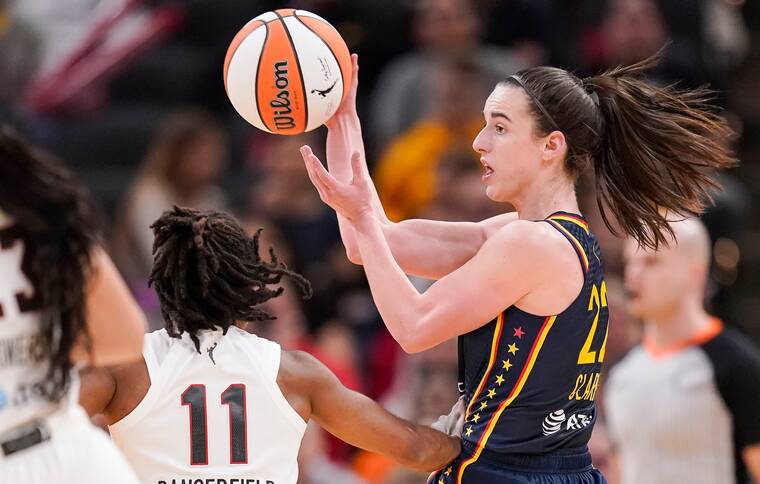Caitlin Clark hype will test the WNBA’s television limits
The decision-makers for the docuseries “Full Court Press” chose wisely when selecting which women’s college basketball players they would follow for an entire season.
They recruited Caitlin Clark, whose long-distance shots at the University of Iowa made her a lucrative draw. Kamilla Cardoso, a Brazilian attending the University of South Carolina, could provide an international perspective. Kiki Rice, from UCLA, would be the talented but reserved young prospect.
ADVERTISING
Those selections proved fortuitous when each player advanced deep into the NCAA Tournament. Clark and Cardoso competed in the most-watched women’s championship game in history before becoming two of the top three picks in the WNBA draft.
“The way that it turned out, it’s like, ‘This is not real life,’” said Kristen Lappas, director of the four-part ESPN series that will air on ABC on Saturday and Sunday. “That just doesn’t happen in documentary filmmaking.”
Interest in women’s basketball is surging because of young talent. Clark, Cardoso and other top rookies including Angel Reese and Cameron Brink are providing the WNBA a vital infusion of star power, quickly obliterating one record when 2.4 million viewers watched April’s draft.
Now the league, whose media rights package expires in 2025, must capitalize by making sure fans can easily follow the players they grew to love during their collegiate careers.
The WNBA ensured that Clark, who scored the most points in Division I history, would get precious real estate by putting 36 of the Indiana Fever’s 40 regular-season games on national television, including her May 14 debut on streaming service Disney+.
But although it aired Clark’s first preseason game on its mobile app, it did not broadcast a preseason game between the Chicago Sky and the Minnesota Lynx the same night, preventing fans from watching Cardoso and Reese. When a spectator inside Target Center in Minneapolis livestreamed that game from her phone, it received more than 600,000 views.
Nancy Lough, a sports management professor at the University of Nevada, Las Vegas, said the misstep showed that the league underestimated the heightened interest.
“It’s clear that the product has been suppressed by the marketplace, and now what we’re seeing is the fans are driving a new business model,” she said.
Clark’s emergence as a national sensation has changed all calculations. She recently appeared on “Saturday Night Live,” and many WNBA teams have relocated their games against the Fever to larger venues to accommodate the increased ticket demand.
In one episode of “Full Court Press,” Clark said she accepted being a catalyst for the sport.
“It’s never something I am trying to do; it’s just because of how I play and the way I act toward people,” she said. “It’s not anything I shy away from, and if that’s what’s going to help move our game forward, then I embrace that.”
To prepare for the influx of talent into the WNBA, the league’s chief marketing officer, Phil Cook, said the organization increased its visibility by buying television ads near the NCAA Tournament. In February, the WNBA cross-promoted a 3-point-shooting competition between Stephen Curry and Sabrina Ionescu during the weekend of the NBA’s All-Star Game. The event drew 5.4 million viewers and was considered by many observers as the highlight of the three-day spectacle.
Lough said that although the WNBA had increasingly provided appointment viewing — such as Thursday night games on Amazon Prime Video — there was still a need for stronger messaging about how to watch games. Broadcasts are scattered across ESPN, ABC, CBS, Prime Video, NBA TV and ION, a television channel owned by Scripps Networks.
“The fans of women’s sports have become adept at searching and finding it — it’s like they’re detectives,” Lough said. “That shouldn’t be the case.”
She added, “I should be able to walk into a sports bar and see the WNBA on, passively, just like any other sport.”
Last year’s WNBA season was its most watched in two decades. And documentaries such as “Full Court Press” that give fans behind-the-scenes looks at their favorite players, Lough said, may further drive interest and lead to sponsorship investments that fortify the WNBA’s media ecosystem.
The docuseries was produced by Omaha Productions, the media company started by former NFL quarterback Peyton Manning, and Words + Pictures, a studio founded by Connor Schell, an executive producer of the acclaimed ESPN documentaries “The Last Dance” and “O.J.: Made in America.”
In a testament to their confidence that “Full Court Press” has broad appeal during this surge in women’s sports, The Walt Disney Co. executives decided to premiere the docuseries on network television instead of its narrower ESPN platforms. It was a common-sense decision, said Brian Lockhart, senior vice president of original content at ESPN.
“We knew there was a rising tide,” he said.
© 2024 The New York Times Company


